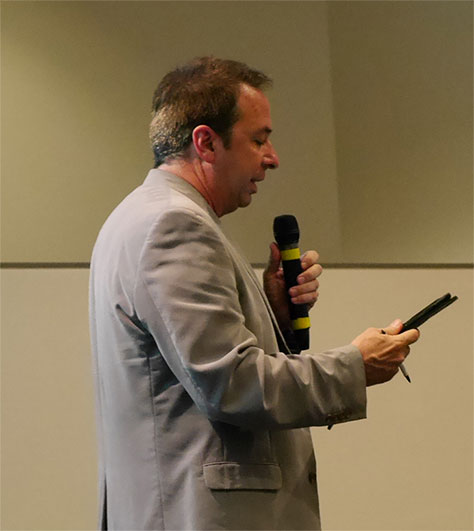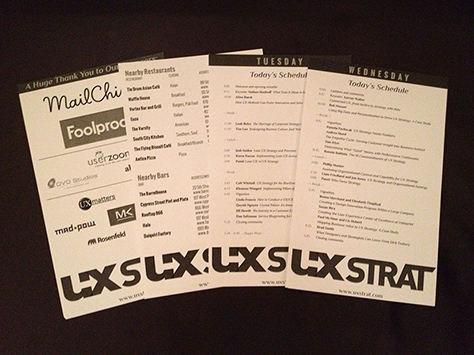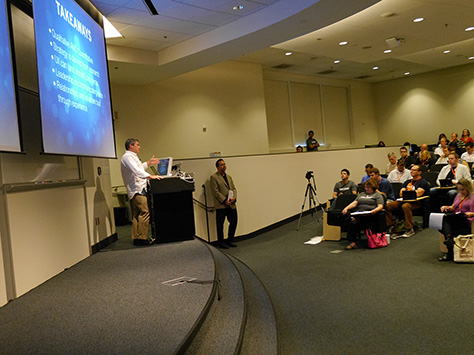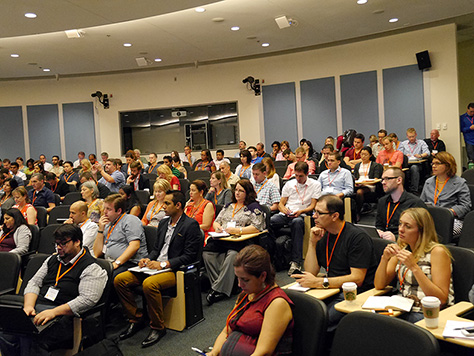
Photo by Pat Lang
Since UX STRAT was a single-track conference, everyone shared a very similar conference experience. Of course, planning a conference program for a single track makes the almost flawless selection of presenters and topics essential to delivering a successful conference.
Paul Bryan acted as host throughout the conference, opening and closing each day of the conference with brief remarks and introducing the speakers. Throughout the day, he and a cadre of volunteers made sure that everyone knew everything they needed to know to keep things running smoothly and be in the right place, at the right time. In closing the conference, Paul conducted an informal, verbal survey, asking the audience questions about the ways in which the conference had or had not been successful, as well as our preferences for the next UX STRAT conference.
The only real snafu that marred the near perfection of this conference was attendees’ inability to sign up for the workshops of their choice in advance of the conference. As a consequence, jetlagged attendees had to line up early on the morning of September 9 to sign up for workshops, and some who had registered for the workshops well before the conference were unable to get into the workshops they had hoped to attend. To accommodate popular demand, two of the workshops became oversubscribed, necessitating the booking of larger rooms for them and catching their presenters unawares, with insufficient handouts for all participants.
Content & Presenters
The conference lived up to its promise, delivering both breadth and depth of content on key UX strategy topics. Overall, the program committee did an excellent job of choosing effective presenters and interesting topics. A few topics misfired—a couple of case studies that failed to deliver content that would be relevant to most UX strategists and a closing presentation that spent too much time establishing a metaphor for innovation and lacked any real payoff. But most of the sessions were very good to great!
According to Paul Bryan’s July 2013 UX Strategy column on UXmatters, “UX STRAT 2013 Conference Focuses on UX Strategy,” the program committee “organized the UX STRAT sessions into thematic blocks, with the intent of giving attendees a comprehensive overview of the key activities within the practice of UX strategy.” But, oddly, neither the conference handouts nor the information on the UX STRAT site called out these themes, which really were the backbone of the conference:
- Establishing a Foundation for UX Strategy
- UX Strategy Methods and Processes
- Aligning UX with Business Strategy
- Using Data to Guide UX Strategy
- UX Strategy in the Organization
Each day of the conference consisted of an opening keynote address—both excellent—some longer talks—lasting between half an hour and 45 minutes—and some brief, 15-minute “vignettes.”
In Parts 2 and 3 of our review of UX STRAT 2013, we’ll cover the conference sessions in detail.
Proceedings
When attendees signed in at the registration desk, we received some small cards, shown in Figure 2, that outlined each day’s schedule and provided lists of nearby restaurants and bars. I found the schedules very handy and easy to use. Since the conference comprised only a single track, a detailed program wasn’t really necessary. The UX STRAT Web site was beautifully designed and provided all essential information. But when I sought greater detail about the sessions on the UX STRAT site during the conference, I found that my bookmark to the site had broken. The Web address had very unexpectedly changed when the conference began.

Presenters have posted all but one of the presentations from the conference sessions on SlideShare,![]() which is great, but there are no links to these presentations on the UX STRAT site. Thanks to all of the presenters who shared their presentations!
which is great, but there are no links to these presentations on the UX STRAT site. Thanks to all of the presenters who shared their presentations!
When the conference organizers post information about future UX STRAT conferences on their Web site, I hope they’ll move the information about this year’s conference to a 2013 subdomain or archival section. It would be a shame to lose this historical information.



